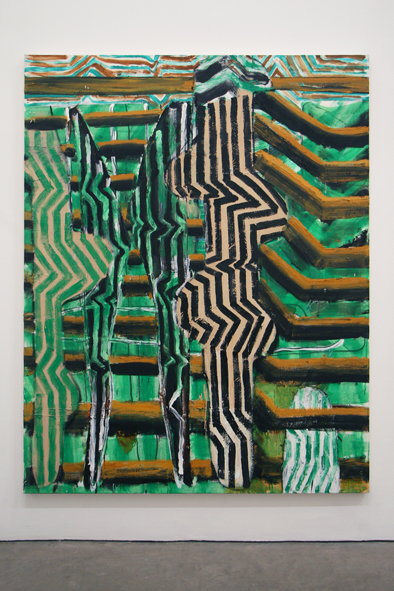 |
| Bram Bogart, 'Binche', Mixed Media, 1984 |
I found myself down in London, with my friend, Susie, recently, and managed to fit in a visit to White Cube's Mason's Yard enclave - where the work of Bram Bogart is currently on show. Dutch-born, and Belgian by adoption - Bogart is an artist I only discovered last Summer, at the end of another long day of gallery-going in London. Although tired, and about to depart for home, I found myself pausing for a minute or two before one of his heavily-built monochrome paintings in a room of similarly all-white works at Tate Modern (you know I can't resist a white painting). There was enough in it to make me want to know more, and it's fortuitous that the chance should come around so soon.
 |
| 'Bram Bogart', White Cube, Mason's Yard, London, February 2020 |
 |
| Bram Bogart, 'Blanc De Brabant', Mixed Media, 1977 |
 |
| Bram Bogart, 'Briques Blanches', Mixed Media, 1992 (Detail Below) |
Bogart seems to fit into a loose affiliation of abstract artists, along with Robert Ryman, or certain American Minimalists, who sought to investigate the very limits of what a painting might actually be, in material (and philosophical) terms, in the post-Abstract Expressionist period. It's a mode of work which could, I suppose, represent that outdated idea of 'the end of painting', or at very least - a logical culmination of high Modernism, in the Greenbergian sense. Certainly, Bogart's mature work, in which 'paint' is so heavily built as to really resemble a construction material, could be said to exist at the point where painting crosses over into sculpture - and in which the behaviour and formal organisation of material is the only real subject.
 |
| Bram Bogart, 'Windzand', Mixed Media, 1963 |
 |
| Bram Bogart 'La Ferme', Mixed Media, 1978 (Detail Below) |
 |
| Bram Bogart 'Donker En Grijs', Mixed Media, 1962 |
Of course, events have long-since discredited that old, Avant-Garde notion of linear, mono-directional progress towards some kind of artistic singularity. Painting resolutely refused to die as a means of expression, and the kind of extreme abstraction that Bogart's work represents, has duly slid in and out of fashion in order for that to occur. What we must now recognise is that this kind of stuff is really just one of the myriad things that painting can do - and thus, no more or less valid than any other. If it represents a limit of some kind, it's surely a border we can enjoy crossing and recrossing as the mood takes us - rather than being one we must traverse only once, never to look back.
 |
| 'Bram Bogart', White Cube, Mason's Yard, London, February 2020 |
 |
| Bram Bogart, 'Printemps Neerlandais', Mixed Media, 1959 |
 |
| Bram Bogart, 'Linaabelina', Mixed Media, 1960 |
Actually, the other artist that most readily came to mind as I browsed with pleasure amongst the Bogarts, is Antoni Tapies. The Spaniard is renowned for his resolute exploration of the ways that base materials (often handled in a singularly crude manner), might be transmuted into something with an almost spiritual resonance. He often spoke of his practice in terms of alchemy, or with a philosophical gravitas verging on the mystical. But, whatever else it may or may not have signified - much of Tapies artistic vision originated in the walls and rugged masonry found in the Gothic Quarter of his native Barcelona.
 |
| Bram Bogart 'Yello Jubel', Mixed Media, 1980 (Detail Below) |
I'm not sure you can necessarily equate Bogart's work with the solemn profundities of Tapies' immense oeuvre, and there is a sometimes a candy-coloured playfulness about the former, that is completely lacking in the latter. But there is, I think, a similar relish for the physicality of material, and a desire to explore its intrinsic qualities and transformative potential. It seems no coincidence that the Dutchman started out as that other (and equally noble) kind of painter - a painter and decorator. Whether articulated or not, such an apprehension is surely intrinsic to that particular trade.
 |
| Bram Bogart, 'Rondwit', Mixed Media, 1975 |
By mixing his pigments with oil, cement, plaster, and other similar ingredients, Bogart was able to concoct self-coloured pastes of such density that the effects of weight and gravity become key factors. in the appearance of a given piece. Indeed, one of the primary themes of all these works is what happens when an extremely viscous liquid becomes a solid. Even more specifically - they seem to catalogue exactly how much a material might sag or spread, or how much a churned or tooled surface might finally settle and pucker, as that extended moment unfurls.
 |
| Bram Bogart, 'Cristal Baroque', Mixed Media, 1959 |
In that respect, the paintings contain the history of their own making in the most direct and substantial manner possible. They are both process and action-driven. It's certainly true that they may chart a certain art-historical moment when pictorial composition was most reductive, or when a form of pictorial architecture aimed above all, to emphasise the physical extent of the picture plane as object. But more urgently, they reach toward something far more primal, and yet simultaneously timeless. They are really memorials to what happens when you get down there in the mud, and squeeze, spread or simply chuck it around in great big dollops. And that never goes out of fashion.
 |
| Bram Bogart, 'Binche', Mixed Media, 1984 (Detail) |
'Bram Bogart' continues until 7 March, at: White Cube, 25 - 26 Mason's Yard, London SW1Y 6BU







































